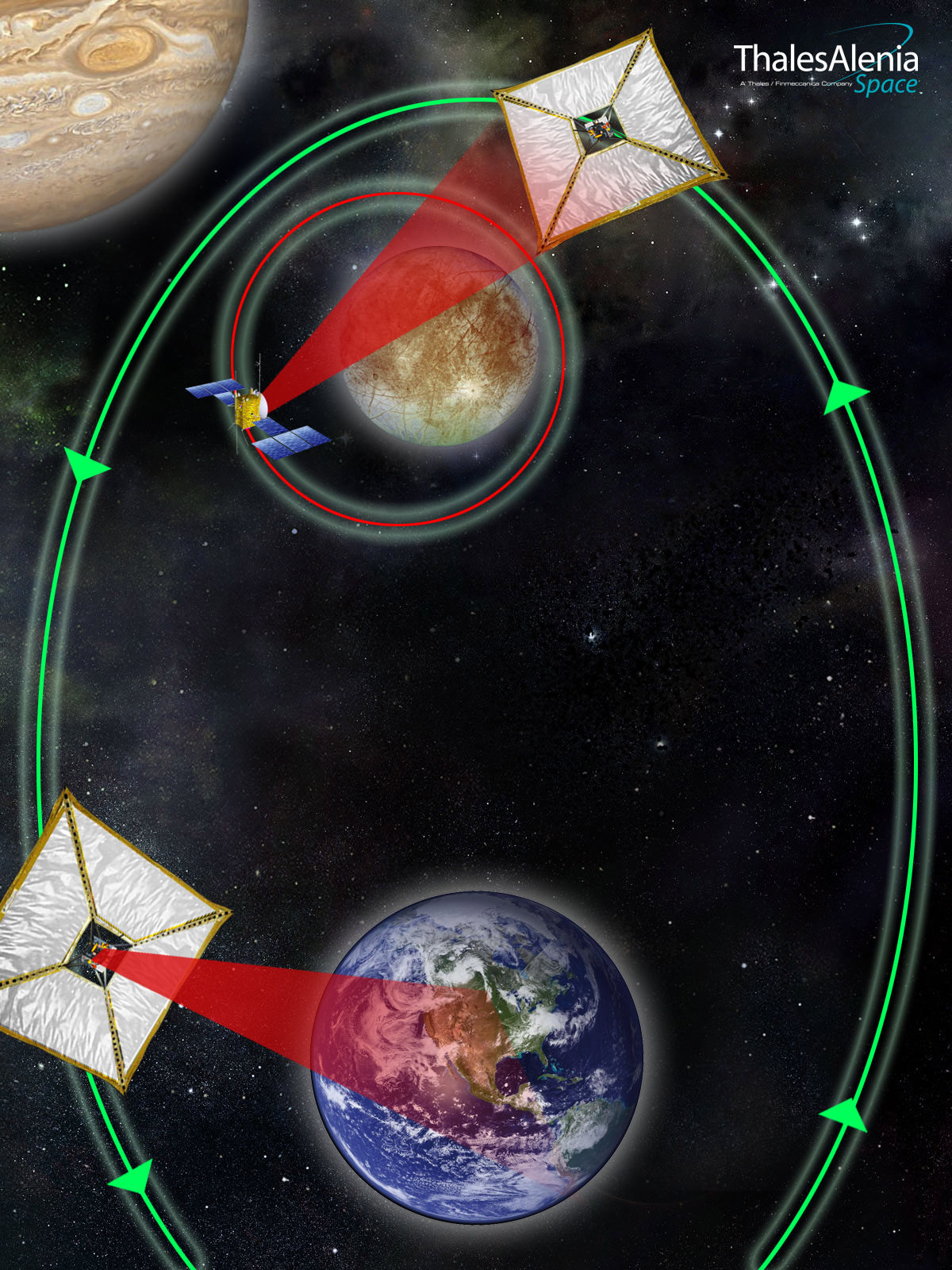[/caption]
Future missions to explore the outer planets could employ fleets of ‘data-clippers’, maneuverable spacecraft equipped with solar sails, to ship vast quantities of scientific data back to Earth. According to Joel Poncy of satellite developer Thales Alenia Space, the technology could be ready in time to support upcoming missions to the moons of Jupiter and Saturn.
“Space-rated flash memories will soon be able to store the huge quantities of data needed for the global mapping of planetary bodies in high resolution.” said Poncy. “But a full high-res map of, say, Europa or Titan, would take several decades to download from a traditional orbiter, even using very large antennae. Downloading data is the major design driver for interplanetary missions. We think that data clippers would be a very efficient way of overcoming this bottleneck.”
Poncy and his team have carried out a preliminary assessment for a data clipper mission. Their concept is for a clipper to fly close to a planetary orbiter, upload its data and fly by Earth, at which point terabytes of data could be downloaded to the ground station. A fleet of data clippers cruising around the Solar System could provide support for an entire suite of planetary missions.
“We have looked at the challenges of a data clipper mission and we think that it could be ready for a launch in the late 2020s. This means that the technology should be included now in the roadmap for future missions,” said Poncy.
Spurred by the success of the Japanese Space Agency’s current solar sail mission, IKAROS, Poncy’s team have assessed the communications systems and tracking devices that a data clipper would need, as well as the flyby conditions and pointing accuracy required for the massive data transfers. Recent advances in technology mean that spacecraft propelled by solar sails, which use radiation pressure from photons emitted by the Sun, or electric sails, which harness the momentum of the solar wind, can now be envisaged for mid-term missions.
“Using the Sun as a propulsion source has the considerable advantage of requiring no propellant on board. As long as the hardware doesn’t age too much and the spacecraft is maneuverable, the duration of the mission can be very long. The use of data clippers could lead to a valuable downsizing of exploration missions and lower ground operation costs – combined with a huge science return. The orbiting spacecraft would still download some samples of their data directly to Earth to enable real-time discoveries and interactive mission operations. But the bulk of the data is less urgent and is often processed by scientists much later. Data clippers could provide an economy delivery service from the outer Solar System, over and over again,” said Poncy.
Poncy will be presenting an assessment of data clippers at the European Planetary Science Congress in Rome on Monday September, 20, 2010.


Wow! With all that data being shipped back to Earth, think of all the new citizen science projects we’ll have! And I’ll be the first to sign up for “Europa Zoo!” 😉
This could be facilitated with orbital transfers between limit cycles and dynamical lagrange-like points.
LC
This strikes me as a very sound idea, if we are going out into the solar system we will need the infrastructure to support the missions. This brings a whole new meaning to the the term “data packet” though.
As the late great Isaac Asimov said . We need to have our minds boggled at least once a day.
What a wonderful period to be alive in.
This would be a great idea, but these data clippers need time to fly back to earth. Will transmitting the data directly be slower then that?
Blurring the software/hardware boundaries yet again. (And for the same reason as always, system bottlenecks.) If the science behind is sound, why not?
pure genius. This will allow the kind of ubiquitous data use that we see with google earth. Perhaps new and wonderful discovers will lie in the reams of data these inter planetary flash drives will bring
The lasers can be used to transfer the huge quantities of data from outer planets and even from stars. It will be more cheaply and sooner.
GeorgiaBracey, just in case you are being insulting to Europeans… remember you have probably been bred here. haha. Lots of good brains here in Europe!
Seriously, solar sail technology may be the solution for journeys within the solar system, provided the idea is workable.
Europa — check out the moons of Jupiter, this is one of the Galilean satelites.
LC
Why should I refrain from pouring the usual bucket of cold water on some poor over-optimistic bastard, just because it’s myself? 😀
It hits me that this will likely fail for the same reason as the other mega space data network projects failed, it takes a concerted effort and investment outside of the usual “project basis financing”. (DSN was initially a cold war result. And now the needed reinvestment is dragging its feet…)
It is still doable if enough people gets enthusiastic about it, but there is much inertia in todays administrative structure.
Ouch, the temperature of that water was frigid!
An interesting idea and a timely assessment… but, as Moore’s law intuits.. by the time we get a Europa or other probe mission off the ground, there might possibly be a better way? Science no longer ‘marches forward’.. indeed, nowadays it tends to RUSH ahead! As a result, I’d expect Lunar crater radio antenna’s or even NEO crater antenna’s to play a role in future space exploration!